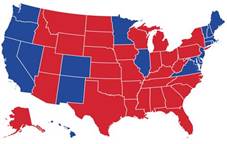By Kollengode S Venkataraman
e-mail: ThePatrika@aol.com
“Red States†and “Blue States,†and “Battleground States†are now part of our everyday vocabulary. Here is the map for the 2016 results. Just to elucidate the point further, as you can see in the table below, many  states repetitively vote for one party only, irrespective of the merits of individual candidates or their stand on key issues of the time. The two parties take these states for granted either for or against them and move on.
states repetitively vote for one party only, irrespective of the merits of individual candidates or their stand on key issues of the time. The two parties take these states for granted either for or against them and move on.
Voters in only a handful of states carefully weigh the candidates and their stands on the  burning issues of the day and switch back and forth in the quadrennial elections. The outcome of the elections is predicated by how these Battleground States swing. The parties spend lots of their time and resources in these states.
burning issues of the day and switch back and forth in the quadrennial elections. The outcome of the elections is predicated by how these Battleground States swing. The parties spend lots of their time and resources in these states.
If we drill down the idea of the Red and Blue states to counties in each state, we get a stark picture. Here is our own state of Pennsylvania. Pennsylvania is a Red Sea of counties with a few Blue islands here and there. The Blue islands are urban centers with dense population around Pittsburgh, Philadelphia, Harrisburg, Allentown… …
If you take this one step further and look at how the votes split between Clinton and Trump, the picture gets starker. In the picture below, Number 1 is for Allegheny County, with Pittsburgh as its center. The table below shows the details of the vote split between Clinton and  Trump and the population of each county. While Clinton got a respectable 16% spread of votes (56% to 40%) over Trump in Allegheny County, in the surrounding
Trump and the population of each county. While Clinton got a respectable 16% spread of votes (56% to 40%) over Trump in Allegheny County, in the surrounding  counties, Clinton got beaten with spreads varying between 25% and 60%. What saved her from humiliation in a generally Democratic state was the smaller populations in these counties. If you go further into the interior, the margin of loss for Clinton was even sharper, as in Juniata County, where the Clinton-Trump split was17%-79%.
counties, Clinton got beaten with spreads varying between 25% and 60%. What saved her from humiliation in a generally Democratic state was the smaller populations in these counties. If you go further into the interior, the margin of loss for Clinton was even sharper, as in Juniata County, where the Clinton-Trump split was17%-79%.
Even in some of the Blue counties (Center, Monroe and Buck Counties), Clinton won by a wafer-thin margin. The pattern of a Red Sea with islands of Blue counties holds in other states as shown further below for Ohio, Oregon, Illinois and Texas.

Now it is obvious why the country is divided sharply between urban and rural Americans on every measure — age, race, education, income, social values, beliefs… … With this sea of Red counties, Republicans have a big majority among local elected officials across the nation, further adding to this disconnect. So, governing becomes difficult since the rancor never subsides after the elections. We could as well be living in two different countries.
Clinton lost in the Electoral College even after getting 2.5 million more popular votes nation-wide than Trump. If she had reduced the margin of loss in rural counties in Battleground States by reaching out to the rural, less educated, and mostly white voters, she would have won the election.
We can only say this to both political parties on the way they strategize their calculus in national elections: This is no way to run your railroad. If you are addressing the Democrats, you can even add this rhetorical flourish: This is one hell of a way to run your railroad!  ♣
